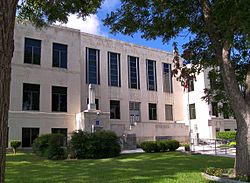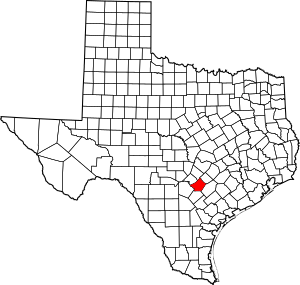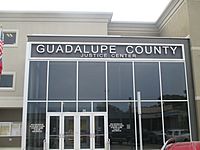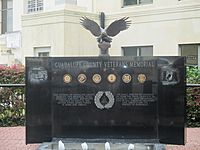Guadalupe County, Texas facts for kids
Quick facts for kids
Guadalupe County
|
|
|---|---|

The Guadalupe County Courthouse in Seguin
|
|

Location within the U.S. state of Texas
|
|
 Texas's location within the U.S. |
|
| Country | |
| State | |
| Founded | 1846 |
| Named for | Guadalupe River |
| Seat | Seguin |
| Largest city | New Braunfels |
| Area | |
| • Total | 715 sq mi (1,850 km2) |
| • Land | 711 sq mi (1,840 km2) |
| • Water | 3.5 sq mi (9 km2) 0.5% |
| Population
(2020)
|
|
| • Total | 172,706 |
| • Density | 241.55/sq mi (93.26/km2) |
| Time zone | UTC−6 (Central) |
| • Summer (DST) | UTC−5 (CDT) |
| Congressional districts | 15th, 28th |
Guadalupe County (Local /ˌɡwɑːdəˈlʊpiː/, Spanish pronunciation: [gwaðaˈlupe]) is a county located in the U.S. state of Texas. As of the 2020 census, its population was 172,706. The county seat is Seguin. The county was founded in 1846 and is named after the Guadalupe River.
Guadalupe County is part of the San Antonio metropolitan statistical area.
Contents
History
Indigenous paleo-Indian hunter-gatherers were the first inhabitants of the area, thousands of years before European colonization. Later, historic Indian tribes settled in the area, including Tonkawa, Karankawa, Kickapoo, Lipan Apache, and Comanche.
In 1689, Alonso de Leon named the Guadalupe River in honor of Our Lady of Guadalupe.
In 1806, French army officer José de la Baume, who later joined the Spanish army, was rewarded for his services to Spain with title to 27,000 acres (11,000 ha) of Texas land, the original El Capote Ranch. The grant was reaffirmed by the Republic of Mexico after it achieved independence.
Following Mexico's independence from Spain, Anglo-Americans from the United States settled in Texas in 1821, and claimed Mexican citizenship. In 1825, Guadalupe County was part of Green DeWitt's petition for a land grant to establish a colony in Texas, which was approved by the Mexican government. From 1827 to 1835, 22 families settled the area as part of DeWitt's colony.
Following Texas' gaining independence from Mexico (1836), 33 Gonzales Rangers and Republic veterans established Seguin. Founded as Walnut Springs in 1838, the settlement's name was changed to Seguin the next year to honor Juan Nepomuceno Seguín, who had fought for independence.
In 1840, the Virginian Michael Erskine acquired the El Capote Ranch for use as a cattle ranch. In 1842, the Republic of Texas organized Guadalupe County as a judicial county. The Texas Supreme Court declared judicial counties to be unconstitutional. In 1845, Prince Carl of Solms-Braunfels secured title to 1,265 acres (512 ha) of the Veramendi grant in the northern part of the former judicial county.
Following the annexation of Texas by the United States (1845), Prussian immigrant August Wilhelm Schumann arrived on the Texas coast aboard the SS Franziska in 1846, and purchased 188 acres (76 ha) in Guadalupe County. Shortly thereafter, the state legislature established the present county from parts of Bexar and Gonzales Counties.
In 1846, during the war between the United States and Mexico, a wagon train of German immigrant settlers bought Guadalupe land from August Schumann. The following year, the town of Schumannsville was established by German immigrants and named after him. Numerous German immigrants entered Texas at Galveston following the revolutions of 1848 in German states, settling in Guadalupe County and central Texas. After their own struggles, they tended to oppose slavery.
The last Indian raid into the area was made by the Kickapoo in 1855.
By 1860, 1,748 slaves of African descent were in the county, generally brought in from the South by slaveholder migrants. In 1861, the people of the county voted 314–22 in favor of secession from the Union. Guadalupe County sent several troops to fight for the Confederate States Army. Following the end of the Civil War and the emancipation of the slaves (1865), a Freedmen's Bureau office opened in 1866 in Seguin to supervise work contracts between former slaves and area farmers. Together, German Americans and African Americans joined the Republican Party, leading Guadalupe County to be a reliably Republican one into the 20th century, even after the state disfranchisement of African Americans in 1901 by imposition of a poll tax.
By 1876, the Galveston, Harrisburg and San Antonio Railway reached Seguin. It was completed as far as San Antonio the following year. By 1880, ethnic Germans accounted for 40% of the county population. Tenant farming and sharecropping accounted for the operation of 25% of the county's farms. By 1910, immigrants from Mexico accounted for about 11% of the country's population.
In 1929, oil was discovered at the Darst Creek oilfield. By 1930, tenant farming and sharecropping comprised 64% of the county's farms.
Over the next five decades, the economy changed markedly, as the area became more urbanized and less dependent on agriculture. By 1982, professional and related services, manufacturing, and wholesale and retail trade involved nearly 60% of the workforce in the area.
Geography
According to the U.S. Census Bureau, the county has a total area of 715 square miles (1,850 km2), of which 711 square miles (1,840 km2) are land and 3.5 square miles (9.1 km2) (0.5%) are covered by water.
Major highways
 Interstate 10
Interstate 10 Interstate 35
Interstate 35 U.S. Highway 90
U.S. Highway 90
 U.S. Highway 90 Alternate
U.S. Highway 90 Alternate State Highway 46
State Highway 46 State Highway 123
State Highway 123 State Highway 130
State Highway 130
Adjacent counties
- Hays County (north)
- Caldwell County (northeast)
- Gonzales County (southeast)
- Wilson County (south)
- Bexar County (southwest)
- Comal County (northwest)
Demographics
| Historical population | |||
|---|---|---|---|
| Census | Pop. | %± | |
| 1850 | 1,511 | — | |
| 1860 | 5,444 | 260.3% | |
| 1870 | 7,282 | 33.8% | |
| 1880 | 12,202 | 67.6% | |
| 1890 | 15,217 | 24.7% | |
| 1900 | 21,385 | 40.5% | |
| 1910 | 24,913 | 16.5% | |
| 1920 | 27,719 | 11.3% | |
| 1930 | 28,925 | 4.4% | |
| 1940 | 25,596 | −11.5% | |
| 1950 | 25,392 | −0.8% | |
| 1960 | 29,017 | 14.3% | |
| 1970 | 33,554 | 15.6% | |
| 1980 | 46,708 | 39.2% | |
| 1990 | 64,873 | 38.9% | |
| 2000 | 89,023 | 37.2% | |
| 2010 | 131,533 | 47.8% | |
| 2020 | 172,706 | 31.3% | |
| 2022 (est.) | 182,760 | 38.9% | |
| U.S. Decennial Census 1850–2010 2010 2020 |
|||
| Race / Ethnicity (NH = Non-Hispanic) | Pop 2000 | Pop 2010 | Pop 2020 | % 2000 | % 2010 | % 2020 |
|---|---|---|---|---|---|---|
| White alone (NH) | 52,858 | 72,086 | 84,063 | 59.38% | 54.80% | 48.67% |
| Black or African American alone (NH) | 4,310 | 7,963 | 11,947 | 4.84% | 6.05% | 6.92% |
| Native American or Alaska Native alone (NH) | 290 | 436 | 476 | 0.33% | 0.33% | 0.28% |
| Asian alone (NH) | 733 | 1,748 | 3,066 | 0.82% | 1.33% | 1.78% |
| Pacific Islander alone (NH) | 77 | 146 | 353 | 0.09% | 0.11% | 0.20% |
| Other race alone (NH) | 119 | 177 | 774 | 0.13% | 0.13% | 0.45% |
| Mixed race or Multiracial (NH) | 1,075 | 2,088 | 6,794 | 1.21% | 1.59% | 3.93% |
| Hispanic or Latino (any race) | 29,561 | 46,889 | 65,233 | 33.21% | 35.65% | 37.77% |
| Total | 89,023 | 131,533 | 172,706 | 100.00% | 100.00% | 100.00% |
As of the census of 2000, 89,023 people, 30,900 households, and 23,823 families were residing in the county. The population density was 125 people/sq mi (48 people/km2). The 33,585 housing units average 47 per square mile (18/km2). The racial makeup of the county was 77.65% White, 5.01% African American, 0.55% Native American, 0.87% Asian, 12.86% from other races, and 3.07% from two or more races. About 33.21% of the population were Hispanics or Latinos of any race.
Of the 30,900 households, 38.30% had children under 18 living with them, 61.60% were married couples living together, 11.20% had a female householder with no husband present, and 22.90% were not families. About 18.90% of all households were made up of individuals, and 7.60% had someone living alone who was 65 or older. The average household size was 2.83, and the average family size was 3.23.
In the county, the age distribution was 28.50% under 18, 9.00% from 18 to 24, 29.10% from 25 to 44, 22.20% from 45 to 64, and 11.30% who were 65 or older. The median age was 35 years. For every 100 females, there were 97.00 males. For every 100 females age 18 and over, there were 94.30 males.
The median income for a household was $43,949, and for a family was $49,645. Males had a median income of $32,450 versus $23,811 for females. The per capita income for the county was $18,430. About 7.30% of families and 9.80% of the population were below the poverty line, including 13.30% of those under age 18 and 9.50% of those 65 or over.
Education
School districts
School districts include:
- Comal Independent School District
- La Vernia Independent School District
- Luling Independent School District
- Marion Independent School District
- Navarro Independent School District
- New Braunfels Independent School District
- Nixon-Smiley Consolidated Independent School District
- Prairie Lea Independent School District
- San Marcos Consolidated Independent School District
- Schertz-Cibolo-Universal City Independent School District
- Seguin Independent School District
Colleges and universities
Most of the county is in the service area of Alamo Community College District. The portion in San Marcos CISD is zoned to Austin Community College.
Texas Lutheran University has about 1,400 students. It is affiliated with the Evangelical Lutheran Church in America. It was ranked number three among the best west regional universities by U.S. News & World Report in 2013. Texas Lutheran is now a member of the Southern Collegiate Athletic Conference, NCAA Division III, with Austin College, Colorado College, Centenary College of Louisiana, Schreiner University, Southwestern University, Trinity University, and the University of Dallas.
Communities
Cities (multiple counties)
- Cibolo (a small portion in Bexar County)
- Luling (mostly in Caldwell County)
- New Braunfels (mostly in Comal County as well as its seat)
- San Marcos (mostly in Hays County and a small part in Caldwell County)
- Schertz (partly in Bexar and Comal Counties)
- Selma (partly in Bexar and Comal Counties)
- Universal City (mostly in Bexar County)
Cities
- Kingsbury
- Marion
- New Berlin
- Santa Clara
- Seguin (county seat)
- Staples
Census-designated places
Unincorporated communities
Ghost town
See also
 In Spanish: Condado de Guadalupe (Texas) para niños
In Spanish: Condado de Guadalupe (Texas) para niños



